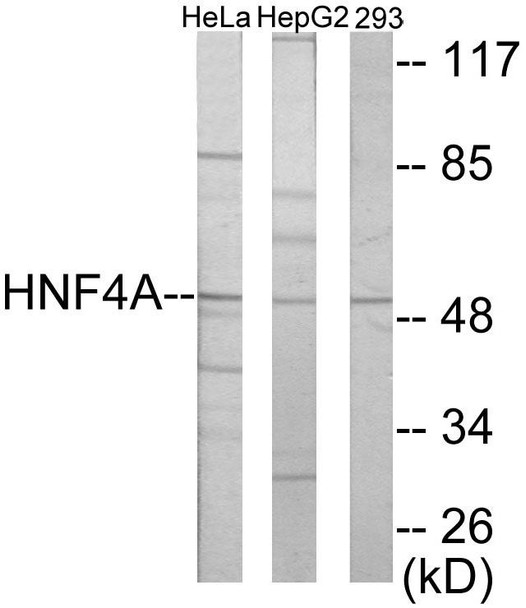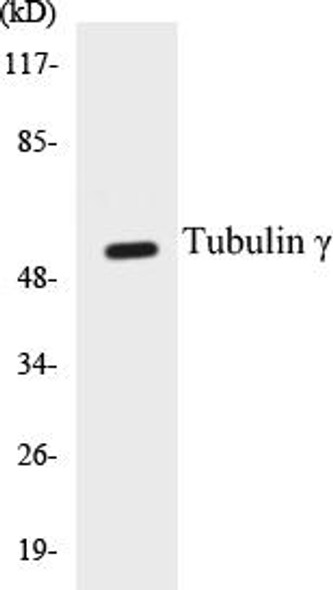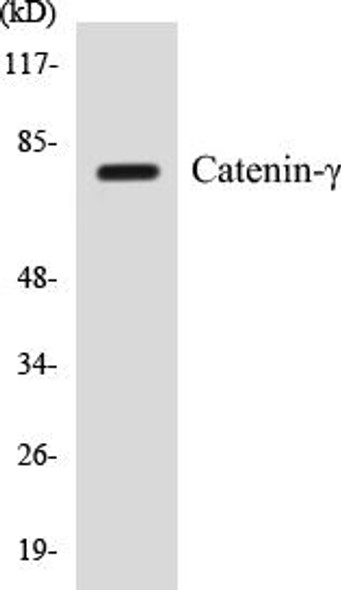Description
HNF4 alpha/gamma Colorimetric Cell-Based ELISA
The HNF4 Alpha/Gamma Colorimetric Cell-Based ELISA Kit from Assay Genie is a cutting-edge tool for the accurate measurement of HNF4 alpha/gamma levels in cell lysates or tissue samples. This kit offers high sensitivity and specificity, delivering precise and reproducible results for your research needs.HNF4 alpha/gamma are key transcription factors involved in the regulation of gene expression, impacting crucial biological processes such as metabolism, cell differentiation, and organ development. Dysregulation of HNF4 alpha/gamma has been linked to various diseases, including diabetes, liver disorders, and certain types of cancer, highlighting their importance as potential therapeutic targets.
With the HNF4 Alpha/Gamma Colorimetric Cell-Based ELISA Kit, researchers can confidently study the role of HNF4 alpha/gamma in disease pathogenesis and identify novel treatment strategies. Trust Assay Genie for reliable and innovative solutions for your research endeavors. Visit the link above for more information and to order your kit today.
| Product Name: | HNF4 alpha/gamma Colorimetric Cell-Based ELISA |
| Product Code: | CBCAB01011 |
| ELISA Type: | Cell-Based |
| Target: | HNF4 alpha/gamma |
| Reactivity: | Human, Mouse, Rat |
| Dynamic Range: | > 5000 Cells |
| Detection Method: | Colorimetric 450 nmStorage/Stability:4°C/6 Months |
| Format: | 96-Well Microplate |
The HNF4 alpha/gamma Colorimetric Cell-Based ELISA Kit is a convenient, lysate-free, high throughput and sensitive assay kit that can detect HNF4 alpha/gamma protein expression profile in cells. The kit can be used for measuring the relative amounts of HNF4 alpha/gamma in cultured cells as well as screening for the effects that various treatments, inhibitors (ie siRNA or chemicals), or activators have on HNF4 alpha/gamma.
Qualitative determination of HNF4 alpha/gamma concentration is achieved by an indirect ELISA format. In essence, HNF4 alpha/gamma is captured by HNF4 alpha/gamma-specific primary antibodies while the HRP-conjugated secondary antibodies bind the Fc region of the primary antibody. Through this binding, the HRP enzyme conjugated to the secondary antibody can catalyze a colorimetric reaction upon substrate addition. Due to the qualitative nature of the Cell-Based ELISA, multiple normalization methods are needed:
| 1. | A monoclonal antibody specific for human GAPDH is included to serve as an internal positive control in normalizing the target absorbance values. |
| 2. | Following the colorimetric measurement of HRP activity via substrate addition, the Crystal Violet whole-cell staining method may be used to determine cell density. After staining, the results can be analysed by normalizing the absorbance values to cell amounts, by which the plating difference can be adjusted. |
| Database Information: | Gene ID: 3172/3174, UniProt ID: P41235/Q14541, OMIM: 125850/600281/606391/605966, Unigene: Hs.116462/Hs.241529 |
| Gene Symbol: | HNF4A |
| Sub Type: | None |
| UniProt Protein Function: | HNF4 alpha: a nuclear transcription factor which binds DNA as a homodimer. Controls the expression of several genes, including hepatocyte nuclear factor 1 alpha, a transcription factor which regulates the expression of several hepatic gene, alpha 1-antitrypsin, apolipoprotein CIII, and transthyretin genes. May be essential for development of the liver, kidney and intestine. Mutations have been associated with monogenic autosomal dominant non-insulin-dependent diabetes mellitus type I. Four alternatively spliced isoforms have been described. |
| UniProt Protein Details: | Protein type:Nuclear receptor; DNA-binding; Transcription factor Chromosomal Location of Human Ortholog: 20q13.12 Cellular Component: nucleoplasm; cytoplasm; nucleus Molecular Function:RNA polymerase II transcription factor activity, enhancer binding; ligand-dependent nuclear receptor activity; protein binding; protein homodimerization activity; DNA binding; zinc ion binding; steroid hormone receptor activity; transcription factor activity; fatty acid binding; receptor binding Biological Process: transcription initiation from RNA polymerase II promoter; regulation of lipid metabolic process; intracellular receptor-mediated signaling pathway; positive regulation of transcription, DNA-dependent; lipid homeostasis; glucose homeostasis; endocrine pancreas development; regulation of transcription from RNA polymerase II promoter; negative regulation of cell proliferation; xenobiotic metabolic process; regulation of gastrulation; response to glucose stimulus; ornithine metabolic process; gene expression; positive regulation of transcription from RNA polymerase II promoter; steroid hormone mediated signaling; lipid metabolic process; negative regulation of cell growth; blood coagulation; regulation of insulin secretion; sex differentiation; phospholipid homeostasis Disease: Fanconi Renotubular Syndrome 4 With Maturity-onset Diabetes Of The Young; Maturity-onset Diabetes Of The Young, Type 1; Diabetes Mellitus, Noninsulin-dependent |
| NCBI Summary: | The protein encoded by this gene is a nuclear transcription factor which binds DNA as a homodimer. The encoded protein controls the expression of several genes, including hepatocyte nuclear factor 1 alpha, a transcription factor which regulates the expression of several hepatic genes. This gene may play a role in development of the liver, kidney, and intestines. Mutations in this gene have been associated with monogenic autosomal dominant non-insulin-dependent diabetes mellitus type I. Alternative splicing of this gene results in multiple transcript variants encoding several different isoforms. [provided by RefSeq, Apr 2012] |
| UniProt Code: | P41235 |
| NCBI GenInfo Identifier: | 148886624 |
| NCBI Gene ID: | 3172 |
| NCBI Accession: | P41235.3 |
| UniProt Secondary Accession: | P41235,O00659, O00723, Q14540, Q5QPB8, Q6B4V5, Q6B4V6 Q6B4V7, Q92653, Q92654, A5JW41, B2RPP8, |
| UniProt Related Accession: | P41235 |
| Molecular Weight: | |
| NCBI Full Name: | Hepatocyte nuclear factor 4-alpha |
| NCBI Synonym Full Names: | hepatocyte nuclear factor 4, alpha |
| NCBI Official Symbol: | HNF4A |
| NCBI Official Synonym Symbols: | TCF; HNF4; MODY; FRTS4; MODY1; NR2A1; TCF14; HNF4a7; HNF4a8; HNF4a9; NR2A21; HNF4alpha |
| NCBI Protein Information: | hepatocyte nuclear factor 4-alpha; TCF-14; HNF4alpha10/11/12; transcription factor 14; transcription factor HNF-4; hepatic nuclear factor 4 alpha; nuclear receptor subfamily 2 group A member 1 |
| UniProt Protein Name: | Hepatocyte nuclear factor 4-alpha |
| UniProt Synonym Protein Names: | Nuclear receptor subfamily 2 group A member 1; Transcription factor 14; TCF-14; Transcription factor HNF-4 |
| Protein Family: | Hepatocyte nuclear factor |
| UniProt Gene Name: | HNF4A |
| UniProt Entry Name: | HNF4A_HUMAN |
| Component | Quantity |
| 96-Well Cell Culture Clear-Bottom Microplate | 2 plates |
| 10X TBS | 24 mL |
| Quenching Buffer | 24 mL |
| Blocking Buffer | 50 mL |
| 15X Wash Buffer | 50 mL |
| Primary Antibody Diluent | 12 mL |
| 100x Anti-Phospho Target Antibody | 60 µL |
| 100x Anti-Target Antibody | 60 µL |
| Anti-GAPDH Antibody | 60 µL |
| HRP-Conjugated Anti-Rabbit IgG Antibody | 12 mL |
| HRP-Conjugated Anti-Mouse IgG Antibody | 12 mL |
| SDS Solution | 12 mL |
| Stop Solution | 24 mL |
| Ready-to-Use Substrate | 12 mL |
| Crystal Violet Solution | 12 mL |
| Adhesive Plate Seals | 2 seals |
The following materials and/or equipment are NOT provided in this kit but are necessary to successfully conduct the experiment:
- Microplate reader able to measure absorbance at 450 nm and/or 595 nm for Crystal Violet Cell Staining (Optional)
- Micropipettes with capability of measuring volumes ranging from 1 µL to 1 ml
- 37% formaldehyde (Sigma Cat# F-8775) or formaldehyde from other sources
- Squirt bottle, manifold dispenser, multichannel pipette reservoir or automated microplate washer
- Graph paper or computer software capable of generating or displaying logarithmic functions
- Absorbent papers or vacuum aspirator
- Test tubes or microfuge tubes capable of storing ≥1 ml
- Poly-L-Lysine (Sigma Cat# P4832 for suspension cells)
- Orbital shaker (optional)
- Deionized or sterile water
*Note: Protocols are specific to each batch/lot. For the correct instructions please follow the protocol included in your kit.
| Step | Procedure |
| 1. | Seed 200 µL of 20,000 adherent cells in culture medium in each well of a 96-well plate. The plates included in the kit are sterile and treated for cell culture. For suspension cells and loosely attached cells, coat the plates with 100 µL of 10 µg/ml Poly-L-Lysine (not included) to each well of a 96-well plate for 30 minutes at 37°C prior to adding cells. |
| 2. | Incubate the cells for overnight at 37°C, 5% CO2. |
| 3. | Treat the cells as desired. |
| 4. | Remove the cell culture medium and rinse with 200 µL of 1x TBS, twice. |
| 5. | Fix the cells by incubating with 100 µL of Fixing Solution for 20 minutes at room temperature. The 4% formaldehyde is used for adherent cells and 8% formaldehyde is used for suspension cells and loosely attached cells. |
| 6. | Remove the Fixing Solution and wash the plate 3 times with 200 µL 1x Wash Buffer for five minutes each time with gentle shaking on the orbital shaker. The plate can be stored at 4°C for a week. |
| 7. | Add 100 µL of Quenching Buffer and incubate for 20 minutes at room temperature. |
| 8. | Wash the plate 3 times with 1x Wash Buffer for 5 minutes each time. |
| 9. | Add 200 µL of Blocking Buffer and incubate for 1 hour at room temperature. |
| 10. | Wash 3 times with 200 µL of 1x Wash Buffer for 5 minutes each time. |
| 11. | Add 50 µL of 1x primary antibodies (Anti-HNF4 alpha/gamma Antibody and/or Anti-GAPDH Antibody) to the corresponding wells, cover with Parafilm and incubate for 16 hours (overnight) at 4°C. If the target expression is known to be high, incubate for 2 hours at room temperature. |
| 12. | Wash 3 times with 200 µL of 1x Wash Buffer for 5 minutes each time. |
| 13. | Add 50 µL of 1x secondary antibodies (HRP-Conjugated AntiRabbit IgG Antibody or HRP-Conjugated Anti-Mouse IgG Antibody) to corresponding wells and incubate for 1.5 hours at room temperature. |
| 14. | Wash 3 times with 200 µL of 1x Wash Buffer for 5 minutes each time. |
| 15. | Add 50 µL of Ready-to-Use Substrate to each well and incubate for 30 minutes at room temperature in the dark. |
| 16. | Add 50 µL of Stop Solution to each well and read OD at 450 nm immediately using the microplate reader. |
(Additional Crystal Violet staining may be performed if desired – details of this may be found in the kit technical manual.)






